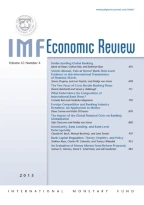Secular Stagnation and Macroeconomic Policy

Secular stagnation theory has developed substantially recently and offers substantial insights that policymakers have yet to fully internalize. This paper reviews the considerations that led me to revive the secular stagnation idea, summarizes the theory as I understand it today, and argues that events since I started advocating the secular stagnation view have tended to confirm its predictions and reject those of its critics. It addresses the various objections, both theoretical and empirical, that have been put forward to the secular stagnation idea, and argues that if secular stagnation is a central macroeconomic issue, much of the conventional wisdom regarding macroeconomic policy needs to be rethought. Contrary to current orthodoxy, monetary policies may be able to have lasting impacts on levels of output but not to determine rates of inflation. Fiscal policies may be essential for assuring full employment and financial stability. Increases in government indebtedness may contribute to financial stability.
This is a preview of subscription content, log in via an institution to check access.
Access this article
Subscribe and save
Springer+ Basic
€32.70 /Month
- Get 10 units per month
- Download Article/Chapter or eBook
- 1 Unit = 1 Article or 1 Chapter
- Cancel anytime
Buy Now
Price includes VAT (France)
Instant access to the full article PDF.
Rent this article via DeepDyve
Similar content being viewed by others

Epilogue
Chapter © 2014

Modern Monetary Theory: Some Additional Dimensions
Article 30 March 2020

Post Keynesian Economics
Chapter © 2018
References
- Abel, Andrew, N. Gregory Mankiw, Lawrence Summers, and Richard Zeckhauser. 1989. Assessing Dynamic Efficiency: Theory and Evidence. Review of Economic Studies, 1–19. http://EconPapers.repec.org/RePEc:oup:restud:v:56:y:1989:i:1:p:1-19.
- Alichi, Ali, Kory Katenga, and Juan Sole. 2016. Income Polarization in the United States. IMF Working Paper.https://www.imf.org/external/pubs/ft/wp/2016/wp16121.pdf.
- Borio, Claudio, and Piti Disyatat. 2011. Global imbalances and the financial crisis. BIS Working Papers.https://www.bis.org/publ/work346.pdf.
- Bureau of Economic Analysis. 2016. National Income and Product Accounts, Table 1.1.6. November.
- Caballero, Ricardo, Emmanuel Farhi, and Pierre-Olivier Gourinchas. 2016. Safe Asset Scarcity and Aggregate Demand. American Economic Review, Papers and Proceedings, 513–518.
- Caballero, Ricardo J., Emmanuel Farhi, and Pierre-Olivier Gourinchas. 2017. The Safe Assets Shortage Conundrum. Journal of Economic Perspectives 31(3): 29–46. ArticleGoogle Scholar
- CBO. 2016. An Update to the Budget and Economic Outlook: 2016 to 2026.https://www.cbo.gov/publication/51908.
- Census. 2016. U.S. Population Estimates By Age and Sex.https://www.census.gov/newsroom/press-releases/2017/cb17-tps38-population-estimates-single-year-age.html.
- Curdia, Vasco. 2015. Why So Slow? A Gradual Return for Interest Rates. FRBSF Economic Letter, October 12.
- Gagnon, Etienne, Benjamin Johannsen, and David Lopez-Salido. 2014. Understanding the New Normal: The Role of Demographics. Finance and Economics Discussion Series.https://www.federalreserve.gov/econresdata/feds/2016/files/2016080pap.pdf.
- Gordon, Robert J. 2015. Secular Stagnation: A Supply-Side View. American Economic Review 105(5): 54–59. https://doi.org/10.1257/aer.p20151102. ArticleGoogle Scholar
- Greenspan, Alan. 1999. Remarks by Chairman Alan Greenspan. February 16. https://www.federalreserve.gov/boarddocs/speeches/current/19990216.htm.
- Greenwood, Robin, Samuel Hansen, Joshua Rudolph, and Lawrence Summers. 2014. Government Debt Management at the Zero Lower Bound. Brooking Hutchins Center Working Paper.https://www.brookings.edu/wp-content/uploads/2016/06/30_government_debt_management_zlb.pdf.
- Hamilton, James, Ethan Harris, Jan Hatzius, and Kenneth West. 2016. “The Equilibrium Real Funds Rate: Past, Present and Future.” May.
- Hansen, Alvin H. 1939. Economic Progress and Declining Population Growth. American Economic Review 29(1): 1–15. Google Scholar
- IMF. 2014. Perspectives on Global Real Interest Rates. World Economic Outlook, April. http://www.imf.org/external/pubs/ft/weo/2014/01/pdf/c3.pdf.
- International Monetary Fund. 2011–2016. World Economic Outlook Databases. Washington, DC, April. https://www.imf.org/external/ns/cs.aspx?id=28.
- Jordà, Òscar, Moritz Schularick, and Alan M Taylor. 2016. Jordà-Schularick-Taylor Macrohistory Database.http://www.macrohistory.net/data/.
- Kiley, Michael. 2015. What Can the Data Tell Us About the Equilibrium Interest Rate. Finance and Economics Discussion Series.https://www.federalreserve.gov/econresdata/feds/2015/files/2015077pap.pdf.
- Kydland, Finn E., and Edward C. Prescott. 1977. Rules Rather than Discretion: The Inconsistency of Optimal Plans. Journal of Political Economy 85(3): 473–491. ArticleGoogle Scholar
- Laubach, Thomas, and John C Williams. 2015. Measuring the Natural Rate of Interest—Redux. November. https://www.brookings.edu/wp-content/uploads/2016/07/WP15-Laubach-Williams-natural-interest-rate-redux.pdf.
- National Bureau of Economic Research. 2016. US Business Cycle Expansions and Contractions.http://www.nber.org/cycles.html.
- Philadelphia Federal Reserve. 2013, 2016. Survey of Professional Forecasters. Q4. https://www.philadelphiafed.org/research-and-data/real-time-center/survey-of-professional-forecasters.
- Rachel, Lukasz, and Thomas D. Smith. 2015. Secular drivers of the global real interest rate. Bank of England Staff Working Paper No. 571.http://www.bankofengland.co.uk/research/Documents/workingpapers/2015/swp571.pdf.
- Rogoff, Kenneth. 1985. The Optimal Degree of Commitment to an Intermediate Monetary Target. The Quarterly Journal of Economics 100(4): 1169–1189. ArticleGoogle Scholar
- Setser, Brad. 2016a. Asia’s Persistent Savings Glut. October 25. http://blogs.cfr.org/setser/2016/10/25/asias-persistent-savings-glut/.
- Setser, Brad W. 2016b. Asia’s Persistent Savings Glut. October 25. https://www.cfr.org/blog/asias-persistent-savings-glut.
- Shiller, Robert. 2016. U.S. Stock Markets 1871–Present and CAPE Ratio.http://www.econ.yale.edu/~shiller/data.htm.
- Summers, Lawrence H. 2013. IMF Fourteenth Annual Research Conference in Honor of Stanley Fischer. Washington, DC, November 8. http://larrysummers.com/imf-fourteenth-annual-research-conference-in-honor-of-stanley-fischer/.
- Summers, Lawrence H. 2015. Have we Entered an Age of Secular Stagnation? IMF Fourteenth Annual Research Conference in Honor of Stanley Fischer, Washington, DC. IMF Economic Review 63(1): 277–280. ArticleGoogle Scholar
Author information
Authors and Affiliations
- Charles W. Eliot University Professor and President Emeritus, John F. Kennedy School of Government, Harvard University, Mailbox 8, 79 JFK Street, Cambridge, MA, 02138, USA Lawrence H. Summers
- Lawrence H. Summers


